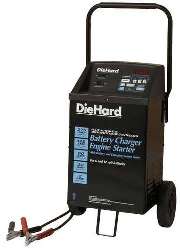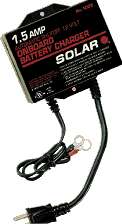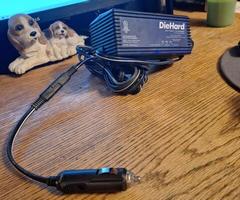The MGA With An Attitude
BATTERY CHARGERS and BATTERY MAINTAINERS - BA-104
Most important point first. For the very frugal, or if you're on a tight budget, a cheap battery charger will work to charge your battery. They can be just a little slow, and you need to pay attention to disconnect it when it's finished. For a little more money you get faster charging, but you still need to be there to disconnect it at the proper time. For more money you can have very fast charging and some nice additional features, like high current engine cranking, deep cycle charging, trickle charging, automatic shutoff, and long term battery maintaining. While you may not need all of these features, the higher output units will have more whistles and bells.
At the cheap end of the scale, a 2 amp manual trickle charger may require two days to fully charge a flat battery, and then it does not shut off. These cheap little units do have one nice application. In cold climates they can be used to keep the battery warm when the car is parked outside. When used on a fully charged battery, a slow trickle charger will generate several watts of heat inside the battery. It is not good to use it this way for really long periods of time, as the constant slow overcharging will eventually damage a battery. If the objective is to keep a battery warm for extended periods through a long winter, a flat pad heater applied to the outside of the battery is a much better solution. If you're thinking about battery maintenance during long term storage, then for a few dollars more you can have a fully automatic start and stop trickle charger called a "battery maintainer".
A short step up scale gets you a 6 or 8 or 10 amp manual battery charger. These are commonly thought of as overnight chargers, but they can work a little faster than that. For a discharged battery the inexpensive charger will output current close to its rated capacity. By the time the battery is half charged the circuit voltage will be rising, and the charger will be dropping in current. When the battery is near full charge this type charger might be down to about 2 amps. A medium size 12 volt car battery might have 48 ampere-hour storage capacity. For full charge starting from a flat battery, the 6 amp rated charger might require about 12 hours, the 8 amp unit about 9 hours, and the 10 amp unit about 6 hours. With any manual charger you need to be there to disconnect it at the appropriate time. If left on charge the manual units will continue to push current through the battery. This cannot increase the charge level beyond the design capacity of the battery, but it is called "overcharging", and it will eventually damage a battery.

One of these inexpensive manual chargers may be useful for starting your car in a much shorter time, if for instance you may have left the headlights on and ran the battery flat. As a battery is discharging the voltage will drop off only a small amount until the thing is mostly discharged, after which the voltage drops rapidly during the last part of discharging. The reverse of that is that a partial charge will bring the voltage up dramatically, so that you may be able to start the car without waiting for full charge. Once the car is running the generator or alternator can recharge the battery faster than the cheap manual charger. If the battery is in good condition but has been nearly fully discharged, a 6 amp charger may bring it up enough to start the car in less than an hour. An 8 amp unit might do it in about 30 minutes, or the 10 amp charger might do it in as little as 20 minutes.
If you feel the need for speed, and you are willing to spend more money, you can buy a larger charger. But don't expect to be able to pump 50 amps into the battery and have it fully charged in one hour. Fast charging a battery for extended periods will harm the battery. Automotive batteries are designed to handle very large currents for only short periods of time for engine cranking. If a high current is forced in or out for an extended period of time, the battery will overheat and suffer internal damage. Better chargers commonly have capability to run a 15 amp charging rate. An important feature of the larger capacity automatic charger is that it may be able to maintain something close to the rated current until the battery is nearly fully charged. Then when it's finished it can shut off suddenly and not overcharge the battery. As such a 15 amp automatic charger may be able to fully charge a flat battery in as little as 3 or 4 hours.

Some battery chargers now incorporate an engine start high current feature. The maximum current output might be 50 amp, 75, 100, 125, 150 amp, you name it you pay for it. While 125 amps might be enough to crank over a small engine with no battery, it is not really intended to be used that way. In fact this starting current output is usually only maintained for about 5 seconds, after which the charger needs an extended cool down time before it can be repeated. This can however work wonders if your battery is not completely discharged. A "400 Cold Cranking Amp" battery in a state of very low charge may be capable of putting out 50 amps. If you add a 50 or 75 amp starting charger to this you can get 100 or 125 amps for 5 seconds, which may be enough to start your car immediately without waiting for charging up the battery. A 125 amp starting charger in conjunction with a partially charged battery might be able to crank over a large engine. As a rule of thumb, for cranking a cool engine (not ice cold) you need about 1 amp for each cubic inch of displacement. So you might crank an MG engine adequately with as little as 100 amps, and 300 amps might crank a sizable V8.
Now we have some questions on the floor.
At 06:02 PM 12/15/04 -0700, Derek Lai wrote:
>I would like to maintain a battery for 6-12 months and I have a new Diehard battery charger/engine starter with 2/10/50 amps charging capabilities. Is this okay for my purposes?"
Yes, but your electric bill might be a bit higher than expected if you leave it on indefinitely in the sleep mode.
I too have a DieHard battery charger/engine starter, but mine's a little bigger. I have a 15/2/125 amp unit. With 125 amps it is actually capable of cranking my MG engine over for a few seconds with no battery.
>"For the 2 amp slow charge, the instruction reads "for charging small batteries and warming large ones".
Mine has three switch settings. Manual - Deep Cycle - Automatic.
The manual setting is NOT good for long term maintenance of a battery. It effectively disables the automatic shut off and runs a constant trickle charge of 1 to 2 amps, pretty much the same as a cheap trickle charger unit. When a battery is fully charged this will force a slight overcharge into the battery. While constantly over charging, it gradually disassociates the water into hydrogen and oxygen by electrolysis, effectively boiling off the water and lowering the fluid level in the battery. A side effect of this process is generating a little heat. This is what makes it effective at keeping a battery warm overnight in cold weather, so it might crank up in the morning like a warm summer day.
Unfortunately the constant overcharging is not good for the health of the battery, so when it's charged up you should come back and disconnect it to avoid damaging the battery. The larger chargers have a timed shut off for the manual mode where it will shut off after 12 to 16 hours of continuous trickle charging. Either way the manual setting is no good for long term battery maintenance. A cheap trickle charger would continue charging indefinitely and ruin the battery. This manual mode shuts off after a time and will never turn back on, which would allow the battery to run down after a while that same as no charger.
The maintenance mode is especially important with newer cars which have on-board computers. These cars have a constant low current parasitic drain on the battery. Batteries in new cars are sized to handle the parasitic drain for up to 30 days and still be able so start the car. But if you leave it parked for 45 to 60 days all bets are off as the battery will be significantly discharged. If you leave it sitting connected for several months without running it will absolutely kill the battery to the point where it will never again accept a charge, just like it had a dead short across the terminals, or like if you left the headlights switched on for a week or more.
Since you cannot allow a battery to overcharge at high current, most of the higher power chargers have an automatic shut off feature (the Automatic switch mode). When the battery is fully charged the voltage goes significantly higher than the nominal 12.6 volts open circuit voltage, and the charging current drops off at the same time. This set of circumstances is programmed to shut it off. Mine has a green LED that blinks when it's charging. When fully charged and shut off the green led stops blinking and remains lit. This state is for practical purposes the same as if you disconnected the charger or pulled the plug, with no current flowing in or out of the battery. That's nice because you don't have to remember to come back to shut it off after a normal charging time period. It does however still consume a little power while in the sleep mode.
It also has a red LED labeled "Check Battery". Glowing red means it's connected in reverse polarity, or not connected, or otherwise cannot induce a charging current (absolutely dead battery for instance). A slow blinking red light can also indicate an abnormally long period required to charge a battery, meaning it's not up to full charge, indicating most likely something wrong with the battery.
The really nice feature of this charger is that it can set connected indefinitely in the Automatic mode. If there is a parasitic current drain, the battery voltage will eventually drop a bit with the discharge. After a few days or maybe a week the voltage will be low enough to cause the automatic charger to turn back on and charge it up again. When once again at full charge it will shut off and wait patiently for the next time of need. In this mode you can leave it connected indefinitely, and it will maintain the battery at full charge without overcharging.
The Automatic Deep Cycle mode is a combination of the other two modes. Here it will operate in the same fully automatic mode, but when switched on it will limit the charging current to low amperage like a trickle charger. This slower charging rate will do a better job of fully charging a deep cycle battery.
>"I am also confused by the fact that I have seen other products with smaller amps called "battery maintainers" with float mode monitors where they say they are specially used for storing batt2ies."

 These are a pocket size version of the automatic battery charger, but have only low current capability of perhaps 1 amp or less. When running in the trickle charge mode they might be slightly more efficient than the "monster" size automatic charger. But efficiency is a moot point when talking about maybe 25 to 30 watts applied for a few hours out of each week or so during long term storage.
These are a pocket size version of the automatic battery charger, but have only low current capability of perhaps 1 amp or less. When running in the trickle charge mode they might be slightly more efficient than the "monster" size automatic charger. But efficiency is a moot point when talking about maybe 25 to 30 watts applied for a few hours out of each week or so during long term storage.
30W x 3.33 hrs = 100 WH
That's only about a penny worth of electricity used for each charging cycle, and maybe only once a week or so.
The more important point about efficiency is how much current the thing draws from the wall while in the sleep mode for weeks and months on end. This is where the cheap little battery maintainers should have an edge, being able to sleep quietly with very low power consumption. My large automatic charger has four stated input currents, with the lowest being 0.37 amps. I presume that would be in the sleep mode.
0.37a x 120v = 44.4 watts
44.4w x 24hr x $.10/kwh = 10.66 cents per day.
That would be $3.20 per month, which will easily pay to buy a small dedicated battery maintainer to do the same job hopefully at a fraction of the cost in sleep mode for long periods of time. That's why the little ones have a market, and you should probably buy one.
The things can be cheap anyway. The first one I Googled up is only $16.99
http://www2.northerntool.com/product-1/12128.htm (broken link 7/22/12)
If you park your car outside, you can have a solar powered one for only $19.95:
http://www2.northerntool.com/product-1/200263124.htm (broken link 7/22/12)
I'm not sure how well this one might work. I think it's only about 1.5 watts (1/8 amp at 12v). But it might be good for a car parked outdoors for months on end without running.
In terms of long term operating cost, the small battery maintainers should have big advantage over your full size automatic charger. You can get an idea of how much power it uses in the sleep mode by touching the box to see how warm it gets, compared to say a 4 or 7 watt incandescent night light bulb. Most small wall transformer power supplies will use about 5 watts at idle when the output is unplugged. That's something like $0.36/mo for the electricity. Of course if you have more than one vehicle to "tend", the small battery maintainers can be fully automatic and cheap to buy and cheap to operate, and they can free up the large charger for important high current emergency use..
|